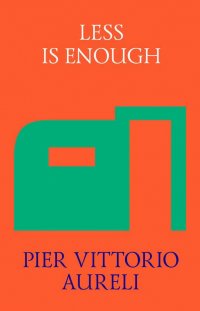Less is Enough: on Architecture and Asceticism = Меньше — значит достаточно: об архитектуре и аскетизме
Покупка
Тематика:
Теория и история архитектуры
Издательство:
Стрелка Пресс
Автор:
Аурели Пьер Витторио
Год издания: 2017
Кол-во страниц: 51
Дополнительно
Вид издания:
Научно-популярная литература
Уровень образования:
Профессиональное образование
ISBN: 978-5-906264-12-1
Артикул: 687986.01.99
«Less is more» goes the modernist dictum. But is it? In an age when we are
endlessly urged to do «more with less», can we still romanticise the pretensions of
minimalism? For Pier Vittorio Aureli, the return of «austerity chic» is a perversion of
what ought to be a meaningful way of life. Charting the rise of asceticism in early
Christianity and its institutionalisation with the medieval monasteries, Aureli examines
how the basic unit of the reclusive life — the monk’s cell — becomes the foundation
of private property. And from there, he argues, it all starts to go wrong. By late
capitalism, asceticism has been utterly aestheticised. It manifests itself as monasteries
inspired by Calvin Klein stores, in the monkish lifestyle of Steve Jobs and Apple’s aura
of restraint. Amid all the hypocrisy, it must still be possible to reprise the idea of «less»
as a radical alternative, as the first step to living the life examined.
Тематика:
ББК:
УДК:
ОКСО:
- 07.00.00: АРХИТЕКТУРА
- ВО - Бакалавриат
- 07.03.01: Архитектура
- 07.03.03: Дизайн архитектурной среды
- ВО - Магистратура
- 07.04.01: Архитектура
- 07.04.03: Дизайн архитектурной среды
ГРНТИ:
Скопировать запись
Фрагмент текстового слоя документа размещен для индексирующих роботов
АУРЕЛИ ПЬЕР ВИТТОРИО МЕНЬШЕ — ЗНАЧИТ ДОСТАТОЧНО: ОБ АРХИТЕКТУРЕ И АСКЕТИЗМЕ 3-е издание (электронное) Москва «Стрелка Пресс» 2017
AURELI PIER VITTORIO LESS IS ENOUGH: ON ARCHITECTURE AND ASCETICISM 3-rd edition (electronic) Moscow Strelka Press 2017
УДК 72
ББК 85
А94
Aureli, Pier Vittorio.
А94 Less is Enough: on Architecture and Asceticism = Меньше — значит достаточно: об архитектуре и аскетизме [Электронный ресурс] / P. Aureli. — 3-rd ed. (el.). — Electronic text data (1 file pdf : 51 p.). — М. : Strelka Press, 2017. — System requirements: Adobe Reader XI or Adobe Digital Editions 4.5 ; screen 10".
ISBN 978-5-906264-12-1
«Less is more» goes the modernist dictum. But is it? In an age when we are endlessly urged to do «more with less», can we still romanticise the pretensions of minimalism? For Pier Vittorio Aureli, the return of «austerity chic» is a perversion of what ought to be a meaningful way of life. Charting the rise of asceticism in early Christianity and its institutionalisation with the medieval monasteries, Aureli examines how the basic unit of the reclusive life — the monk’s cell — becomes the foundation of private property. And from there, he argues, it all starts to go wrong. By late capitalism, asceticism has been utterly aestheticised. It manifests itself as monasteries inspired by Calvin Klein stores, in the monkish lifestyle of Steve Jobs and Apple’s aura of restraint. Amid all the hypocrisy, it must still be possible to reprise the idea of «less» as a radical alternative, as the first step to living the life examined.
УДК 72
ББК 85
The source print publication: Less is Enough: on Architecture and Asceticism = Меньше — значит достаточно: об архитектуре и аскетизме / P. Aureli. — Moscow : Strelka Press, 2014. — 50 p. — ISBN 978-0-9929-1460-8.
ISBN 978-5-906264-12-1
© Strelka Institute for Media, Architecture and Design, 2014
INTRODUCTION
For many years, ‘less is more’ has been the catchphrase of minimalist design. Instantly associated with the restrained work of the German architect Ludwig Mies van der Rohe, who borrowed this dictum from a poem by Robert Browning,[1-] ‘less is more’ celebrates the ethical and aesthetic value of a self-imposed economy of means. Mies’s stripped-bare architecture, in which formal expression was reduced to a simple composition of readymade industrial elements, implied that beauty could only arise through refusal of everything that was not strictly necessary. In recent years, but especially since the 2008 economic recession, the ‘less is more’ attitude has become fashionable again, this time advocated by critics, architects and designers in a slightly moralistic tone.[2]
If in the late 1990s and early 2000s architecture was driven by the irrational exuberance of the real-estate market towards the production of increasingly redundant iconic objects, with the onset of the recession the situation started to change. Those who had previously acclaimed (or even produced) the acrobatics of architecture in the previous decade now took to complaining about architecture’s shameful waste of resources and budgets. [3] This change of sensibility has provoked two kinds of reaction. Some architects have tried to translate the ethos of austerity in merely formal terms. [4] Others have advocated a more socially minded approach, trying to go beyond the traditional boundaries of architecture.!⁵] It would be
— 5 —


